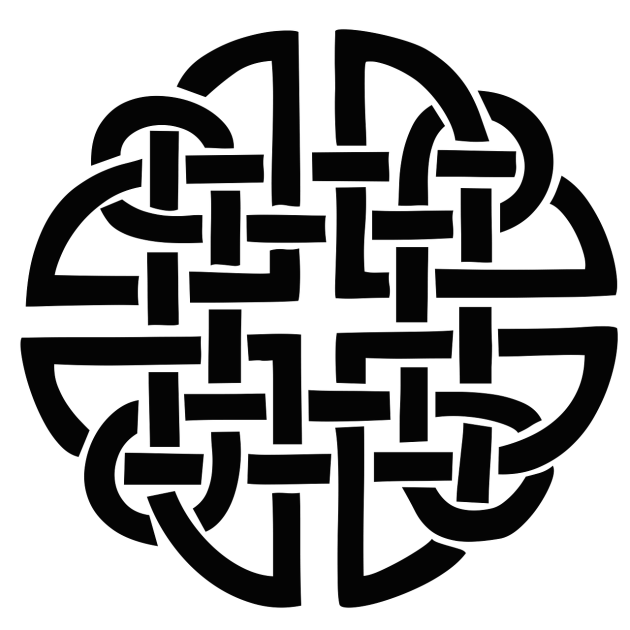


A Celtic Knot is a symbolic pattern of a looped knot that has no start or finish. The looped pattern goes on infinitely, which is thought to symbolise the eternity of life.
You can date the use of Celtic Knots all the way back as far as the 8th century, used in artwork and decoration. Some researchers have even suggested that Celtic Knots could have been used as far back as 500 B.C, however, it’s difficult to find enough evidence from so long ago.
A Celtic Knot’s meaning can vary, since they have a lot of different interpretations. They’re generally viewed as a positive symbol, which can signify emotions such as love and happiness, as well as virtues such as faith and friendship. The overarching meaning seems to be the interconnectivity of life.
There is a long and fascinating history behind Celtic Knots, dating back to around the 3rd century AD. However, it was not just the Celts who were fond of using knot motifs in their art. There is evidence of knots being used in Roman, Byzantine, Ethiopian, Russian and Islamic art and architecture as well.
Knots were used frequently in Celtic art and, due to the rise in popularity of Christianity in Ireland around 450 AD, the knots began to appear more and more in various religious manuscripts and artwork. The earliest example we have of these knots being used in religious materials can be found in a Gospel Book from the 7th century.
However, the most notable use of Celtic Knots in a religious manuscript is in the famous Book of Kells. This book, which is named after the Abbey of Kells in County Meath, is an ancient Latin manuscript containing the four Gospels of the New Testament: Matthew, Mark, Luke and John. One of the reasons that the Book of Kells is so popular is because of the stunning display of artwork that can be found throughout the ancient text. The Book of Kells contains a combination of traditional Christian iconography, which is to be expected considering the religious nature of the text. However, it also includes a collection of beautifully complex Celtic Knots and breathtaking calligraphy.
Celtic Knots were central to an art style that developed around the 600s AD called Insular artwork. The Book of Kells is one of the primary examples of this style of artwork, featuring an abundance of intricate, interwoven Celtic Knots. Insular artwork can also be found throughout the Lindisfarne Gospels, which were made between 715 and 720 AD. These gospels detail the life and works of Jesus Christ through a series of artwork of Celtic, Germanic and Irish inspiration. As time went on, the Celtic Knots in these manuscripts evolved, becoming increasingly intricate and complex.
There are 8 main styles of Celtic Knot that we see being used in various pieces of artwork and decoration in history, each with their own interpretations. Here’s a list of the 8 Celtic Knots that will be explained:
The Trinity Knot might be one of the most recognisable styles of Celtic Knot, since it’s probably the first design that people will think of when reading about Celtic artwork.
The Trinity Knot is known for its three oval loops that overlap each other and are interconnected. This is where the knot derives its Latin name ‘Triquetra’, which means ‘three-cornered’.
The number 3 is significant in ancient Celtic culture, since the Celtic people favoured anything that comes in threes. This is the basis for this Celtic Knot’s meaning, which can be interpreted in various ways. Here are some of the interpretations of the symbolism of the Trinity Knot:

The Celtic Cross is another very common form of the Celtic Knot. The Celtic Cross is also sometimes referred to as the Irish Cross and is made up of a crucifix, with a ring around the crossing of the lines to make four semi-circles. Some Celtic Crosses also have interwoven looping patterns along the beams of the cross, similar to the pattern of most Celtic Knots.
This Celtic Knot’s meaning is twofold, since it’s said to represent both Celtic culture and religion. The origin of the Celtic Cross isn’t known for certain, but one popular legend says that it was St. Patrick who introduced the Celtic Cross to Ireland, during his effort to convert Irish Pagans into Christians.
Today, the Celtic Cross has become a cultural symbol of Ireland. You can see it being used in Irish artwork and even as a popular pattern for tattoos.

A Celtic Love Knot is a very distinctive Celtic Knot design. It is made up of two interlacing knots, each forming the shape of a heart. The knots weave between each other to make one heart face downwards and the other face upwards. Despite appearing like two separate knots, the Celtic Love Knot is made up of one continuous line.
It goes without saying that this Celtic Knot’s meaning is love. The two interlocking hearts represent two people joined together in love, and the continuous line represents the eternity of love. According to historians, Celtic Love Knots were exchanged between people as a token of affection, much like how we exchange rings today.

Solomon’s Knot is arguably one of the lesser-known Celtic Knots, especially because its use in modern times has been dropped in favour of more popular designs, such as the Trinity Knot. Solomon’s Knot is a simple design, with an interweaving string making four oval corners. Its lines are often drawn straighter and less curved than that of other Celtic Knot designs.
The name of the knot comes from the fact that it often appears in ancient synagogues that were associated with the Israeli King Solomon. This Celtic Knot’s meaning is said to be symbolic of the intrinsic connection between man and the divine.

The Shield Knot was a very commonly used design, with this Celtic Knot’s meaning unmistakably representing defence and protection. The noticeably compact style of this knot intentionally resembles a shield, with its overlapping lines leaving little empty space within and the curved outer corners enclosing the knot.
In Celtic history, the Shield Knot would often be placed on battlefields to ward off enemies by demonstrating strength and protection. They were sometimes also placed outside of homes, places of worship and around sick people, as they were thought to also protect people from evil spirits.

A Sailor’s Celtic Knot may be one of the simplest Celtic Knot designs, but also one of the physically strongest. The pattern is made by interlacing a rope around itself to make a long, weaving knot. Despite the appearance of two ropes, the design of this knot is actually just one rope looping around itself, then joining back up to itself to make an infinite loop.
The meaning behind this Celtic Knot can be determined by its history. It’s thought that this design was created by sailors who were at sea for a long time. In their spare time, they would create these knots as a way of remembering their family and feeling closer to them. Some say the strength of this knot represents the strength of the bond between families.

Similar to the physical strength of the Sailor’s Celtic Knot and the strength between families in the Sailor’s Celtic Knot, the Dara Knot is often used as the visual representation of strength in Celtic culture. This Celtic Knot’s meaning comes from the muse of this design - the oak tree. The name ‘Dara’ derives from the Gaeilge word ‘dair’, which means ‘oak tree’.
In Celtic culture, the roots of trees connect to ancestors and all living things. The design of the Dara knot is meant to represent this connection that the trees have, as well as the people’s connection to each other and their ancestors. The Dara Knot has one intricately interwoven rope that loops together to make a complex and infinite pattern.

The Celtic Spiral Knot is comparable to the Trinity Knot, as it’s another three-sided knot. The design of this knot is made up of one line that splits off into three spirals. The Celtic Spiral Knot was often placed on monuments and places of worship, due to its spiritual connotations.
The meaning of this Celtic Knot is believed to signify the three forces of nature: water, fire and earth. The single line is said to signify the oneness of the spirit, and the spirals represent growth. The gaps in the spirals symbolise the stages of life: life, death and rebirth.

If you enjoyed learning about the Celtic Knot meanings, and you want to learn more about Celtic culture, why not take a look at our wikis about the Celtic People and Celtic Art? This will help you to understand even more how important these symbols were in Celtic culture.
If you are teaching your children about Celtic culture, we have a collection of fantastic resources to help you cover the subject. You can explore our range of high-quality, teacher-made materials to help you create engaging, informative lessons, without having to spend tons of unnecessary time on planning. We have PowerPoints, worksheets, games, crafts, display materials and more for you to choose from!
Here are some of our favourites to get you started:
All of these resources and thousands more are available to download and print whenever you need them with a Twinkl subscription, so why not go ahead and subscribe to Twinkl now?